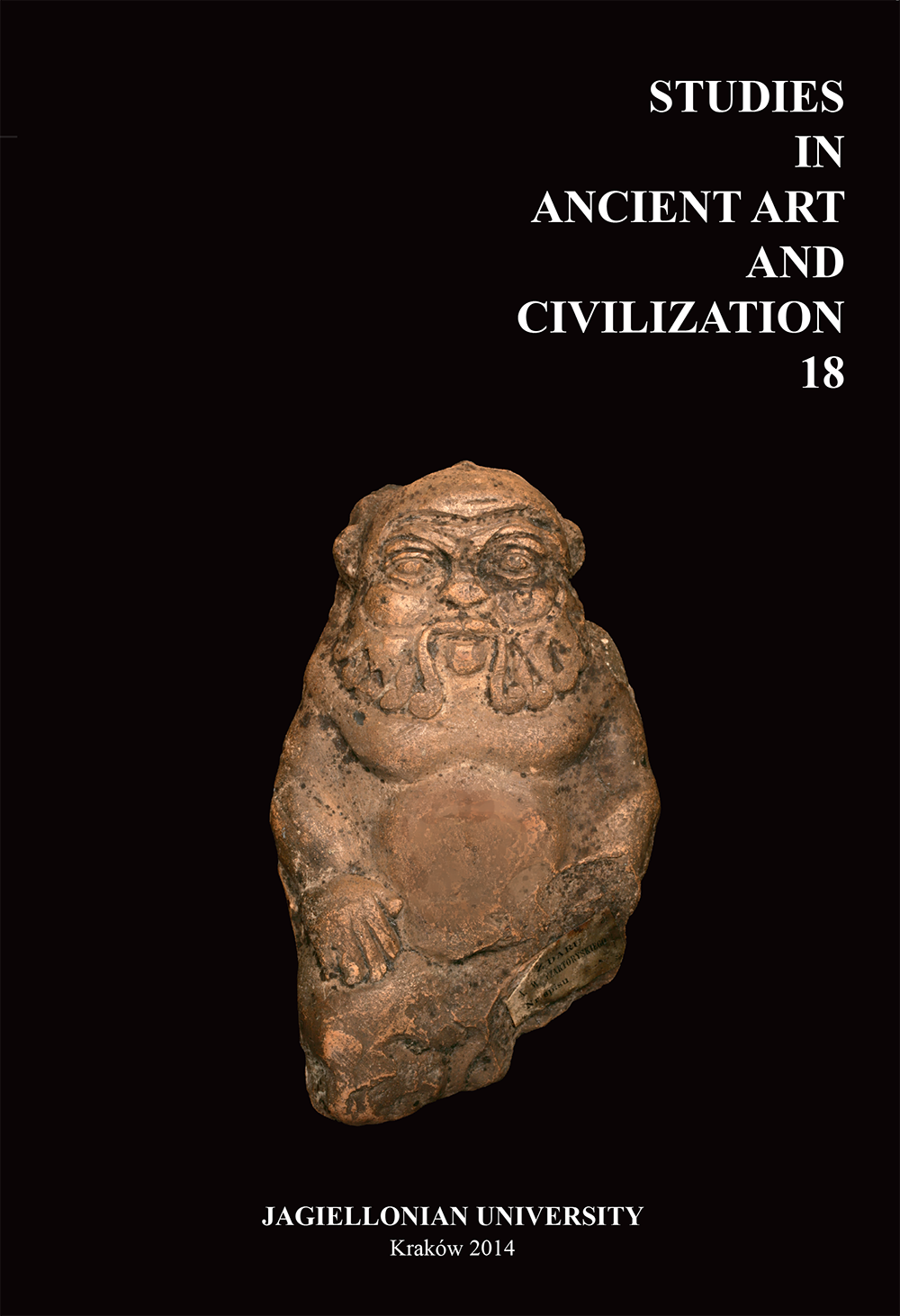In the Shadow of Wepwawet
An Early Necropolis on Gebel Asyut al-Gharbi?
DOI:
https://doi.org/10.12797/SAAC.18.2014.18.06Keywords:
Asyut, Predynastic and Early Dynastic period, necropolis, potteryAbstract
Asyut, known as Siut in ancient times, was the capital of the 13th Nome of Upper Egypt. It is situated precisely in the middle of Egypt at a crossroads of routes running from north to south and east to west. The site is mainly recognised as a place where Wepwawet and Anubis were worshipped and for being the burial ground of the nomarchs in the 1st Intermediate period/Period of Regions and the Middle Kingdom. Although the city’s name appears in texts dating back to the 5th Dynasty and is predated by depictions of Wepwawet, it is only recently that evidence of an early necropolis has been found on the gebel in Asyut. It was the German-Egyptian mission of the Asyut Project (Johannes Gutenberg University of Mainz/Free University in Berlin/Sohag University) working on the site for the last ten seasons, which managed to locate an early cemetery.
References
Aston B. G. 1994. Ancient Egyptian Stone Vessels. Materials and Forms. (Studien zur Archäologie und Geschichte Altägyptens 5). Heidelberg.
Brunton G. 1927. Qau and Badari 1. (BSAE/ERA 29). London.
Chassinat É. and Palanque Ch. 1911. Une campagne de fouilles dans la nécropole d’Assiout. (MIFAO 24). Cairo.
Engel E.-M. 1997. Abydos, Umm el-Qa’ab, Grab des Chasechemui. Bulletin de liason du Group international d’étude de la céramique égyptienne 20, 25-28.
Firth C. M. and Quibell J. E. 1935. The Step Pyramid. Cairo.
Friedman R. F. 1994. Predynastic Settlement Ceramics of Upper Egypt: a Comparative Study of the Ceramics of Hamamieh, Nagada, and Hierakonpolis. Unpublished PhD thesis, University of California, Berkeley. Berkeley.
George B. 1975. Frühe Keramik aus Ägypten: die dekorierte Negade II Keramik im Medelhavsmuseet. (MedMusB 10). Stockholm.
Huyge D. 2003. An enigmatic Third Dynasty Mastaba at Elkab. Egyptian Archaeology 22, 29-30.
Kahl J. 1999. Siut Theben: zur Wertschätzung von Traditionen im alten Ägypten. (PÄ 13). Leiden, Boston, Cologne. DOI: https://doi.org/10.1163/9789004675452
Kahl J. 2007. Ancient Asyut. The First Synthesis after 300 Years of Research. (The Asyut Project 1). Wiesbaden.
Kahl J. 2012a. Regionale Milieus und die Macht des Staates im Alten Ägypten: die Vergöttlichung der Gaufürsten von Assiut. SAK 41, 163-188.
Kahl J. 2012b. Asyut and the Asyut Project. In J. Kahl, M. El-Khadragy, U. Verhoeven and A. Kilian (eds), Seven Seasons at Asyut. First Results of the Egyptian-German Cooperation in Archaeological Fieldwork. Proceedings of an International Conference at the University of Sohag, 10th-11th of October 2009, 1-29. (The Asyut Project 2). Wiesbaden.
Kahl J. 2013. Die Zeit selbst lag nun tot darnieder. Die Stadt Assiut und ihre Nekropolen nach westlichen Reiseberichten des 17. bis 19. Jahrhunderts: Konstruktion, Destruktion und Rekonstruktion. (The Asyut Project 5). Wiesbaden.
Kaiser W. 1957. Zur inneren Chronologie der Nagadakultur. Archaeologia Geographica 6, 69-77.
Klemm R. and Klemm D. 2006. Unpublished Geological Report on the Occasion of a Visit to Gebel Asyut in 2005.
Köhler E. Ch. 1998. Tell el-Faraʻîn – Buto 3. Die Keramik von der späten Naqada-Kultur bis zum frühen Alten Reich (Schichten III bis VI). (AV 94). Mainz.
Kopp P. 2006. Die Siedlung der Naqadazeit. (Elephantine 32; AV 118). Mainz.
Lilyquist Ch. with Contributions by Edward W. Castle. 1995. Egyptian Stone Vessels: Khian Trough Tuthmosis IV New York.
Limme L. 2008. Elkab, 1937-2007: seventy years of Belgian archaeological research. British Museum Studies in Ancient Egypt and Sudan 9, 15-50. Retrieved from http://www.britishmuseum.org/research/publications/online_journals/bmsaes/issue_9/limme.aspx (status as of Dec. 13th, 2014).
Mace A.C. 1909. The early Dynastic Cemeteries of Naga ed-Dêr. Part II. (University of California publications in Egyptian archaeology 3). Leipzig.
Needler W. and Churcher C. S. 1984. Predynastic and Archaic Egypt in the Brooklyn Museum. (WM 9). New York.
Op de Beck L. 2004. Possibilities and restrictions for the use of Maidum bowls as chronological indicators. Cahiers de la céramique égyptienne 7, 239-280.
Petrie W. M. F. 1921. Corpus of Prehistoric Pottery and Palettes. London.
Raue D. 1999. Ägyptische und nubische Keramik der 1.-4. Dynastie. In W. Kaiser, F. Arnold, M. Bommas, T. Hikade, H. Jaritz, P. Kopp, W. Niederberger, J.-P. Paetznick, C. von Pilgrim, B. von Pilgrim, D. Raue, T. Rzeuska, S. Schaten, A. Seiler, L. Stalder and M. Ziemermann, Stadt und Tempel von Elephantine, 25./26./27. Grabungsbericht. MDAIK 55, 173-189.
Raue D. 2007. Pottery from the Hierakonpolis Fort, appendix to Renée Friedman, new observations on the Fort at Hierakonpolis. In H. Hawass and J. Richards (eds), The Archaeology and Art of Ancient Egypt: Essays in Honor of David B. O’Connor, 329-336. (ASAE Supplément 36). Cairo.
Reisner G. A. 1908. The early Dynastic Cemeteries of Naqa ed-Dêr. (University of California Publications in Egyptian Archaeology 2). Leipzig.
Rzeuska T. 2012. Pottery. In J. Kahl, M. El-Khadragy, U. Verhoeven, M. Abdelrahiem, M. van Elsbergen, H. Fahid, A. Kilian, Ch. Kitagawa, T. Rzeuska and M. Zöller-Engelhardt, The Asyut Project: ninth season of fieldwork (2011). SAK 41, 209-233.
Rzeuska T. I. forthcoming. Chronological Overview of Pottery from the Necropolis in Asyut. A Contribution to the History of Gebel Asyut al-gharbi. (The Asyut Project 6). Wiesbaden.
Steinmann F. 1998. Tongefäße von der Vordynastischen Zeit bis zum Ende des Mittleren Reiches. (Katalog Ägyptischer Sammlungen in Leipzig Band 2). Mainz.
Zitman M. 2010. The Necropolis of Assiut. A Case Study of Local Egyptian Funerary Culture from the Old to the End of the Middle Kingdom I-II. (Orientalia Lovaniensia Analecta 180). Leuven.
Downloads
Published
Issue
Section
How to Cite
Funding data
-
Narodowym Centrum Nauki
Grant numbers UMO-2011/01/M/HS3/03423 -
Deutsche Forschungsgemeinschaft
Grant numbers Asyut Project






